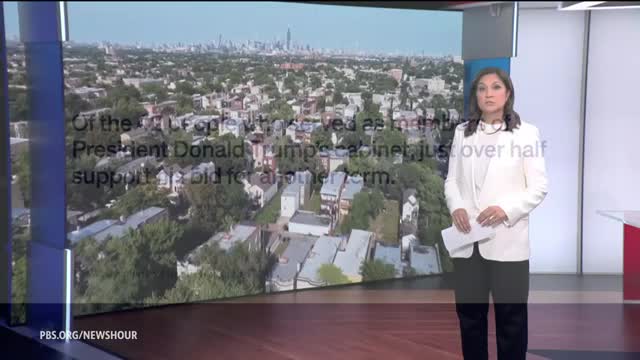Chicago's gun violence rooted in history of racism and neglect
This article was created by AI summarizing key points discussed. AI makes mistakes, so for full details and context, please refer to the video of the full meeting. Please report any errors so we can fix them. Report an error »

Chicago continues to grapple with one of the highest rates of gun violence among major U.S. cities, a crisis deeply rooted in a legacy of racism, inequality, and systemic neglect. During a recent PBS NewsHour report, Judy Woodruff highlighted the stark disparities faced by communities like North Lawndale, where young residents like 16-year-old DeMarian Spann are striving to reshape the narrative surrounding their neighborhoods.
North Lawndale, historically significant as a site of Martin Luther King Jr.'s activism, is characterized by a life expectancy that lags twelve years behind wealthier areas of the city. Unemployment rates are nearly double the city average, and crime rates are three times higher. Despite these challenges, local youth are working to counteract the negative perceptions often portrayed in the media, which tend to focus solely on violence.
Lady Sanders, who organizes youth-led tours through the nonprofit My Block, My Hood, My City, emphasizes the importance of showcasing the community's rich history and resilience. These tours not only empower local youth but also foster understanding among outsiders about the complexities of life in North Lawndale.
The historical context of segregation and violence in Chicago is critical to understanding the current landscape. Franklin Cozy Gay, director of the University of Chicago Medicine's violence recovery program, points to over a century of discriminatory practices that have perpetuated economic disparities, including a staggering $3 to $4 billion wealth gap between white and Black residents. He notes that systemic issues, such as redlining and restrictive housing policies, have hindered Black Chicagoans' ability to build wealth and stability.
As the city has largely responded to gun violence with increased policing, community leaders argue that this approach has failed to address the root causes of the issue. Spann expressed frustration over the lack of political attention to the concerns of youth in his community, while Pastor Phil Jackson of the Firehouse Community Art Center highlighted the need for investment in social services and economic opportunities.
Jamal Cole, founder of My Block, My Hood, My City, advocates for a holistic approach to combat gun violence, focusing on community engagement and support for local youth. He emphasizes the importance of building relationships and providing resources to help young people navigate their challenges.
The report underscores a critical need for systemic change, not only from government entities but also from within the community itself. Spann, who aspires to pursue a political career, aims to challenge the expectations placed on young Black men from neighborhoods like North Lawndale, demonstrating that change is possible.
As Chicago continues to confront its legacy of violence and inequality, the voices of its youth and community leaders are essential in shaping a more hopeful future.
North Lawndale, historically significant as a site of Martin Luther King Jr.'s activism, is characterized by a life expectancy that lags twelve years behind wealthier areas of the city. Unemployment rates are nearly double the city average, and crime rates are three times higher. Despite these challenges, local youth are working to counteract the negative perceptions often portrayed in the media, which tend to focus solely on violence.
Lady Sanders, who organizes youth-led tours through the nonprofit My Block, My Hood, My City, emphasizes the importance of showcasing the community's rich history and resilience. These tours not only empower local youth but also foster understanding among outsiders about the complexities of life in North Lawndale.
The historical context of segregation and violence in Chicago is critical to understanding the current landscape. Franklin Cozy Gay, director of the University of Chicago Medicine's violence recovery program, points to over a century of discriminatory practices that have perpetuated economic disparities, including a staggering $3 to $4 billion wealth gap between white and Black residents. He notes that systemic issues, such as redlining and restrictive housing policies, have hindered Black Chicagoans' ability to build wealth and stability.
As the city has largely responded to gun violence with increased policing, community leaders argue that this approach has failed to address the root causes of the issue. Spann expressed frustration over the lack of political attention to the concerns of youth in his community, while Pastor Phil Jackson of the Firehouse Community Art Center highlighted the need for investment in social services and economic opportunities.
Jamal Cole, founder of My Block, My Hood, My City, advocates for a holistic approach to combat gun violence, focusing on community engagement and support for local youth. He emphasizes the importance of building relationships and providing resources to help young people navigate their challenges.
The report underscores a critical need for systemic change, not only from government entities but also from within the community itself. Spann, who aspires to pursue a political career, aims to challenge the expectations placed on young Black men from neighborhoods like North Lawndale, demonstrating that change is possible.
As Chicago continues to confront its legacy of violence and inequality, the voices of its youth and community leaders are essential in shaping a more hopeful future.
View full meeting
This article is based on a recent meeting—watch the full video and explore the complete transcript for deeper insights into the discussion.
View full meeting